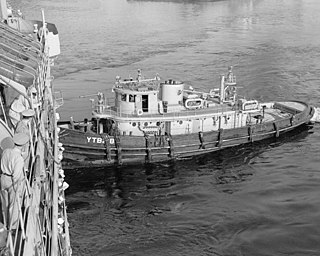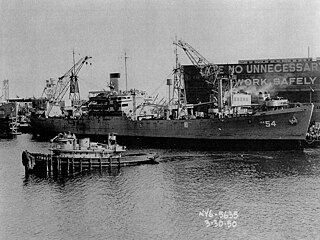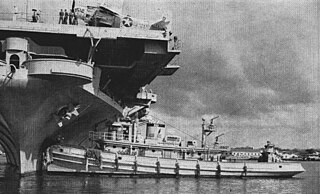USS Watseka (YTM-387) was a medium harbor tug of the YTM-192 class in the service of the United States Navy during World War II. She may be one of the Naval vessels named for a woman since Watseka was the name of a Potawatomi woman. However, the Naval Historical Center lists the namesake as: "Possibly a variant spelling of Watsaghika, a former village of the Iruwaitsu Shasta Indian tribe of northern California, at the extreme west end of Scott Valley."

USS Achigan (YT/YTB-218) was a Cahto-class large harbor tug in the service of the United States Navy. A French-Canadian rendering of the word ashigan which, in Chippewa and Algonquian dialects, is the name of the smallmouth bass.

Hoga (YT-146/YTB-146/YTM-146) was a United States Navy Woban-class district harbor tug named after the Sioux Indian word for "fish." After World War II, the tug was known as Port of Oakland and then City of Oakland when she was a fireboat in Oakland, California.
USS Navajo (ATR-138/ATA-211) was an auxiliary ocean tug in the United States Navy.
USS Resolute may refer to:

USS Awatobi (YTB-264) was a harbor tugboat acquired by the U.S. Navy during the close of World War II. She was outfitted with two .50-caliber machine guns and assigned to the San Francisco Bay area where she provided tug services, and other harbor services as required.

USS Wenonah (YT-148/YTB-148/YTM-148) was a Woban-class district harbor tug which served during World War II in California ports, and continued her service until she was struck by the Navy in 1974. On 17 August 2009, the Wenonah sank while berthed at Treasure Island, CA and was raised by the floating crane Left Coast Lifter on 28 August 2009.
USS Hackberry (YN-20/AN-25) was an Aloe-class net laying ship built for the United States Navy during World War II. She was originally ordered and laid down as USS Maple (YN-20) but renamed shortly before her October 1941 launch. She was later transferred to the French Navy as Araignée (A727).

USS Kittaton was a Sassaba-class district harbor tug that served the U.S. Navy at the end of World War II. She served in the Pacific Ocean, often in the Japan and Philippine Islands area and was eventually struck from the Navy list at an unspecified date.

The third USS Osceola (YT-129), previously USS YT-129, later YTB-129, later YTM-129, was a United States Navy harbor tug commissioned in 1938 and sold for scrapping in 1973.
USS Waubansee (YTB-366), originally YT-366, later YTM-366, was a United States Navy harbor tug commissioned in 1944 and stricken in 1983.

The third USS Hiawatha (YT-265), later YTB-265, later YTM-265, was a type V2-ME-A1 harbor tug that entered service in the United States Navy in 1942 and was sold in 1987.

USS Alamingo (YT-227) was laid down on 13 April 1944 at Camden, New Jersey, by the Mathis Yacht Building Co.; reclassified a large harbor tug and redesignated YTB-227 on 15 May 1944; launched on 21 October 1944; and placed in service on 19 February 1945.

USS Menoquet (YTM-256) was laid down as YT‑256 by Anderson and Cristofani, San Francisco, California 11 September 1943; named Menoquet 5 January 1944; launched 5 February 1944, sponsored by Mrs. Alfred Cristofani; reclassified YTB‑256 on 15 May 1944; and completed and placed in service at Mare Island, California., 7 June 1944.

USS Oneyana (YTB-262) was a U.S. Navy tugboat laid down as YT–262, 20 June 1943 at J.M. Martinac Shipbuilding Corp., Tacoma, Washington launched 27 March 1944; reclassified YTB 262, 15 May 1944: and placed in service 23 August 1944.

USS Neoga (YTB-263) was laid down as YT–263, 24 December 1943, by the J.M. Martinac Shipbuilding Corp., Tacoma, Washington; named Neoga 28 April 1944; reclassified YTB–263, 15 May 1944; launched 13 June 1944; and placed in service 21 October 1944.

The USS Pinola (ATA-206) was a Sotoyomo-class auxiliary fleet tug launched in 1945 and serving until 1956. The ship was transferred to the Republic of Korea in 1962.

The Type V ship is a United States Maritime Commission (MARCOM) designation for World War II tugboats. Type V was used in World War II, Korean War and the Vietnam War. Type V ships were used to move ships and barges. Type V tugboats were made of either steel or wood hulls. There were four types of tugboats ordered for World War II. The largest type V design was the sea worthy 186-foot (57 m) long steel hull, V4-M-A1. The V4-M-A1 design was used by a number of manufacturers; a total of 49 were built. A smaller steel hull tugboat was the 94-foot (29 m) V2-ME-A1; 26 were built. The largest wooden hull was the 148-foot (45 m) V3-S-AH2, of which 14 were built. The smaller wooden hull was the 58-foot (18 m) V2-M-AL1, which 35 were built. Most V2-M-AL1 tugboats were sent to England for the war efforts under the lend-lease act. The Type V tugs served across the globe during Work War II including: Pacific War, European theatre and in the United States. SS Farallon and other Type V tugs were used to help built Normandy ports, including Mulberry harbour, on D-Day, June 6, 1944 and made nine round trips to Normandy to deliver Phoenix breakwaters.
Everett-Pacific Shipbuilding & Dry Dock Company was established in 1942 to build ships needed for World War 2. As part of the Emergency Shipbuilding Program the US Navy provided some of the capital to start Everett-Pacific Shipbuilding at Port Gardner Bay in Everett, Washington. Everett-Pacific was sold in 1945 to the Pacific Car and Foundry, who was already a major manufacturer of railcars and trucks. Pacific Car and Foundry was building barges for the US Navy during World War 2 at plants in Renton, Seattle and Tacoma in the state of Washington. The lease for the shipyard in Everett, Washington ended in 1949 and the yard closed. Pacific Car and Foundry in 1972 changed its name to Paccar Inc. to reflect its major products. The Everett-Pacific shipyard site later became part of Western Gear, a heavy machinery manufacturer. in 1987 the shipyard became part of Naval Station Everett. Everett-Pacific Shipbuilding was started by William Pigott, Jr. a Seattle businessmen and his brother Paul Pigott (1900-1961). William Pigott, Jr. was born in 26 Aug. 1895 in Pueblo, CO and died on 8 July 1947 in San Francisco, CA.











